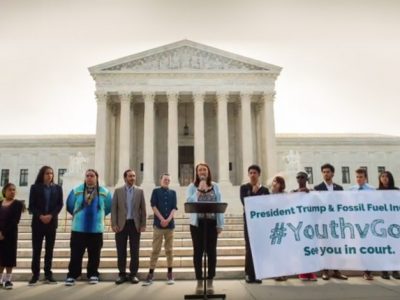
In the landmark Juliana litigation, the youth plaintiffs sought a judicial decree telling the federal government to develop and implement a plan to do its part to reduce atmospheric CO2 concentrations to 350 ppm. The Ninth Circuit dismissed Juliana, holding that the youth plaintiffs’ constitutional and public trust claims were not redressable by an Article III court. The panel concluded it lacked the power to order a carbon-reduction plan because the judiciary would need to “pass judgment on the sufficiency of the government’s response” and the plan would “demand action . . . by Congress.” The court was also “skeptical” that the requested relief would redress the youth plaintiffs’ climate injuries because it would “not solve global climate change.” Working both within and outside the Ninth Circuit’s framework, how can future climate plaintiffs successfully plead redressability after Juliana?
Future Ninth Circuit Cases
Future plaintiffs could identify particular remedies that the executive branch can implement under existing law that would be simple to administer. For example, they might ask for the government to tighten vehicle mileage standards, to end fossil fuel leasing on public lands, or to stop approving new pipeline projects. In regulating fuel economy standards, the Secretary of Transportation has the discretion to set the standards to any level, so long as they are economically practicable. The Secretary of the Interior has discretion to deny applications if leasing the land would be contrary to the public interest for environmental or other reasons. The President has discretion to issue permits for pipelines that cross national borders.
But asking for more limited remedies may create new challenges. A court may question whether the emissions associated with any specific government policy are a major causal factor in the plaintiffs’ injuries, which would destroy their standing in a different way. And given courts’ lack of scientific and policy expertise, they may be even less willing to order a specific policy than the Juliana Court was to order the government to devise its own wide-ranging plan. Moreover, there is a concern that if plaintiffs seek a specific policy change by an agency, they will bolster the government’s argument that their claims must be brought under under the Administrative Procedure Act or other substantive statutes. This route would force plaintiffs to follow specific procedural requirements and modes of judicial review before they could make any constitutional claim. The Juliana Court rejected the government’s argument on this point precisely because the plaintiffs did not claim that any specific agency action exceeded statutory limitations, or was arbitrary or capricious; rather, the plaintiffs claimed that it was the culmination of the government’s actions that deprived them of constitutionally protected rights.
A future constitutional climate change lawsuit in the Ninth Circuit would also need to overcome the Juliana majority’s overbroad suggestion that plaintiffs flunk redressability unless their remedy “solve[s] global climate change.” But this part of the opinion is only dictum: the panel majority noted its “skeptic[ism]” that a climate plan would redress plaintiffs’ injuries but rested its actual decision on the basis of its inability to award the remedy. Moreover, the Ninth Circuit’s argument seems inconsistent with the Supreme Court’s decision in Massachusetts v. EPA, holding that remedies sufficiently redress climate harms so long as they “slow the pace of global emissions increases.”
The Ninth Circuit tried to distinguish Massachusetts v. EPA as involving a “procedural right,” which relaxes the redressability analysis. In that case, states claimed that the EPA had wrongly rejected its petition to regulate CO2. The Court relaxed its redressability analysis by not requiring states to show that forcing the EPA to revisit their petition would necessarily cause the agency to change its mind. But, as Judge Staton recognized in her Juliana dissent, once the Court had done the work of “removing the procedural link from the causal chain,” it resumed its “traditional analysis to determine whether the desired outcome,” regulating CO2, “would in fact redress plaintiffs’ harms.” The Court found that slowing the rise of global emissions redresses climate harms only after it assumed away the procedural aspect of the case.
Outside the Ninth Circuit
Future plaintiffs looking for a Juliana-style remedy could argue that the Ninth Circuit overstated the difficulty of supervising a plan to achieve a certain level of atmospheric carbon. By ordering the government to develop and implement a plan to reach 350 ppm by 2100, the court would not need “to muck around” itself in a broad range of policymaking because executive agencies would ultimately decide how to tackle emissions. As in many administrative law settings, a court could just require the government to report back regularly on the progress of implementation and even appoint a special master to assess whether the government’s policies are in fact translating into progress.
Indeed, courts can and have issued broad injunctive relief to vindicate fundamental rights by enforcing numerical standards. In Brown v. Plata, the Supreme Court affirmed a court-mandated population limit in order to remedy the violation of prisoners’ constitutional rights. The remedy in Plata resembled the requested relief in Juliana: an order requiring California’s prison crowding to a constitutional level (137.5% of design capacity). But the state remained free to chart its own path to constitutional compliance, whether that meant building more prisons or releasing prisoners.
And as Justice Breyer observed in his dissent in Printz v. United States, the “experience [of other nations] may . . . cast an empirical light on the consequences of different solutions to a common legal problem.” Courts across the world, from the Netherlands to Colombia, have issued robust judicial remedies to address climate harms notwithstanding administrability concerns. In the Netherlands, the Supreme Court ordered the Dutch government to cut emissions and meet its 25-40% reduction target. In Colombia, the Supreme Court ordered national and local government agencies to design and implement short, medium, and long-term action plans to tackle deforestation in the Amazon forest. There is no reason why the U.S. courts should consider themselves “exceptional” in their inability to supervise a plan.
Ultimately, no matter how novel or political the issue may seem, courts have a responsibility to uphold the Constitution. In Brown v. Board of Education, the Supreme Court ordered what at the time many observers deemed unimaginable: the desegregation of public schools across the United States. The holding in Brown was certainly not an “easy” decision, but the Court stepped up to the challenge to guarantee equal protection under the law. The request for a plan is thus “consistent with our historical practices” and “a recognition that remedying decades of institutionalized violations may take some time.”
In sum, Juliana’s disappointing result leaves room for future climate plaintiffs to allege redressable injuries. Plaintiffs within the Ninth Circuit may point to specific policies that agencies should administer and invoke Massachusetts v. EPA’s assertion that the redressability test is satisfied so long as remedies can “whittle away” at harms. At this writing, federal judges are exercising their injunctive powers to demand that governments act to protect criminal and immigration detainees from the threat of COVID-19, through release from detention if necessary. There is no reason why plaintiffs in other circuits cannot similarly demand that courts exercise their broad injunctive powers to generate a practical climate plan to address a global existential threat, particularly when fundamental rights are at stake.
Matt Lifson is a student in Yale Law School’s Peter Gruber Rule of Law Clinic and a master’s student at Yale’s School of Forestry and Environmental Studies.
Camila Bustos is a student in Yale Law School’s Peter Gruber Rule of Law Clinic and a plaintiff in the Colombian lawsuit on deforestation and future generations.
Natasha Brunstein is a student in Yale Law School’s Peter Gruber Rule of Law Clinic interested in climate change law and policy.
The post Guest Contributors Matt Lifson, Camila Bustos, and Natasha Brunstein: Redressability of Climate Change Injuries after Juliana appeared first on Legal Planet.
By: Guest Contributor
Title: Guest Contributors Matt Lifson, Camila Bustos, and Natasha Brunstein: Redressability of Climate Change Injuries after Juliana
Sourced From: legal-planet.org/2020/06/12/guest-contributors-matt-lifson-camila-bustos-and-natasha-brunstein-redressability-of-climate-change-injuries-after-juliana/
Published Date: Fri, 12 Jun 2020 16:58:44 +0000
Vist Maida on Social Me
Website Links
Maida Law Firm - Auto Accident Attorneys of Houston, by fuseology

No comments:
Post a Comment